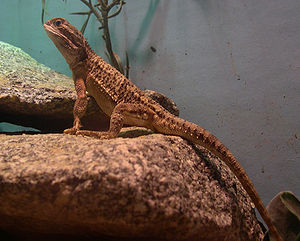Dwarf bearded dragon
| Dwarf bearded dragon | ||||||||||||
|---|---|---|---|---|---|---|---|---|---|---|---|---|

Little bearded dragon ( Pogona henrylawsoni ) |
||||||||||||
| Systematics | ||||||||||||
|
||||||||||||
| Scientific name | ||||||||||||
| Pogona henrylawsoni | ||||||||||||
| Wells & Wellington , 1985 |
The dwarf bearded dragon ( Pogona henrylawsoni ) is a species of lizard from the genus of bearded dragons ( Pogona ) in the family of agamas (Agamidae). It is one of the smallest species in the genus.
The Pogona minor , as suggests its Latin name, also as Zwergbartagame referred.
features
The dwarf bearded dragon reaches a head-trunk length of up to 15 cm, the tail is 90% of it slightly shorter than the head and trunk. In addition to the short hind legs and the rather short tail, the typical proportions of the dwarf bearded dragon include a squat head and a poorly developed beard without enlarged spines on the throat. Spines can be found at the back of the jaw, on the shoulders and in 1–4 rows along the flanks. The color consists of a pale olive to brown or yellowish basic shade with two rows of pale spots between the neck and the base of the hind legs.
There is a possibility of confusion with the western bearded dragon ( Pogona minor ), which does not occur in the same area as the dwarf bearded dragon . Furthermore, the dwarf bearded dragon differs from other bearded dragons in that it has only 18 or fewer lamellae under the fourth toe and 12 or fewer preanal and femoral pores each.
Occurrence
The distribution area is limited to central Queensland , from Croydon to the south to Augathella . There the dwarf bearded dragon inhabits the treeless "black soil plains", which are criss-crossed by dry cracks and overgrown with " Mitchell Grass " ( Astrebla ).
Way of life
Almost nothing is known about the way the dwarf bearded dragon lives in nature. Unlike most bearded dragons, it does not sunbathe on raised branches or fence posts, which is probably due to the habitat. Instead, they mostly sunbathe on rocks and use crevices or burrows as shelter. First they flee from people to a hiding place; if cornered, they threaten their beards and ultimately bite.
Two other reptiles restricted to the black soil plains have been confirmed as predators , namely Spencer's monitor lizard ( Varanus spenceri ) and the black otter ( Pseudechis colletti ). In addition, dwarf bearded dragons are parasitized by mites.
Terrariums
The dwarf bearded dragon is a popular pet in terrariums due to its small size and easy durability. In terrariums with very realistic furnishings, according to new findings, they can reach an age of up to 25 years.
Hibernation in terrariums is increasingly seen as an essential part of the well-being of the animals kept. The observance of the winter rest reflects the living conditions of the dwarf bearded dragon in their natural habitat and leads to an optimization of the immune system.
The greatest challenge of keeping in captivity is mainly the reproduction of the natural light spectrum. In addition to the natural light color and brightness possible, dwarf dragons need a balanced proportion of ultraviolet light, which is required for the formation of vitamin D3 in the animals' skin.
One of the most common diseases of bearded dragons in private animal husbandry is rickets , in which the storage of calcium in the bones is reduced or completely impossible.
further reading
- Christian Freynik & Oliver Drewes: The bearded dragon, dwarf bearded dragon and Australian pigeon dragon. Vivaria-Verlag, Meckenheim 2011, ISBN 978-3-9813176-4-0 .
- Christian Freynik: The dwarf bearded dragon. Pogona henrylawsoni. Vivaria-Verlag, Meckenheim 2007, ISBN 978-3-9810412-4-8 .
Individual evidence
- ^ A b c Steve Wilson, Gerry Swan: A complete guide to reptiles of Australia. 3rd edition. New Holland Publishers, Sydney et al. 2010, ISBN 978-1-877069-76-5 .
- ^ A b c Harold G. Cogger: Reptiles & Amphibians of Australia. 6th edition. Ralph Curtis Books, Sanibel, Florida 2000, ISBN 0-88359-048-4 .
- ^ A b Grant Turner, Rob Valentic: Notes on the occurrence and habits of the Downs Bearded Dragon Pogona henrylawsoni (Wells & Wellington, 1985). In: Herpetofauna. Vol. 28, No. 1, 1998, ISSN 0725-1424 , pp. 12-18.
- ↑ Richard Jackson, Jeffrey M. Lemm: Stomach Content Note for a Road-killed Varanus spenceri. In: Biawak. Vol. 3, No. 1, 2009, ISSN 1936-296X , pp. 18-20, digitized version (PDF; 1.87 MB) .
- ^ GM Shea: The holotype and additional records of Pogona henrylawsoni Wells & Wellington, 1985. In: Memoirs of the Queensland Museum. Vol. 38, No. 2, 1995, ISSN 0079-8835 , p. 574.
- ↑ Andree Hauschild, Hubert Bosch: Bearded Dragons and Collared Lizard. Natur-und-Tier-Verlag, Münster 1997, ISBN 3-931587-17-7 (5th edition, ibid. 2007, ISBN 978-3-931587-17-8 ).
- ↑ Terraristic Compendium: Health. Retrieved September 13, 2017 .